The world of Pokémon
Legends: Arceus is unlike any you’ve explored before. Set in the Sinnoh
region’s distant past (when it was known as the Hisui region), things are very
different than what you’re used to seeing in Pokémon games. The relationship
between humans and Pokémon is much more complex in Hisui, and the lack of
modern-day technological advancements changes the way you interact with the
world. To keep you from experiencing culture shock, we’ve put together a list
of some of the differences to expect when you set off on your journey across
Hisui.
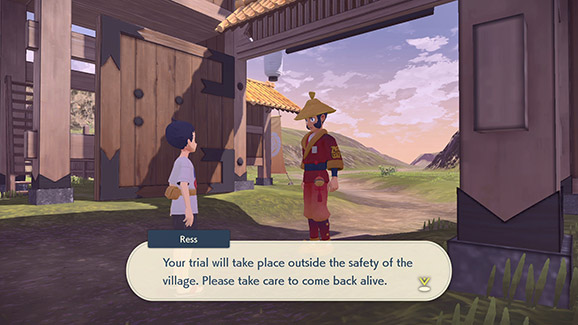
Perhaps the most
surprising aspect of the Hisui region is that people are usually wary of—and
sometimes downright afraid of—Pokémon. Far from the loving bond of friendship
that’s shared between Pokémon and people in modern times, the residents of
Jubilife Village seldom leave the safety of the guarded village gates for fear
of running into a wild Pokémon.
This abundance of
caution isn’t without good cause, though. At the time Pokémon Legends: Arceus takes place, Jubilife Village has only been
around for two years. With some Pokémon prone to attack any human that
encroaches on their territory, these early years have proved to be quite a
trial. It can be dangerous out there, but fortunately, your aptitude for
battling and catching Pokémon makes you a perfect fit for the Galaxy Team’s
Survey Corps, which is dedicated to studying the Hisui region’s Pokémon.
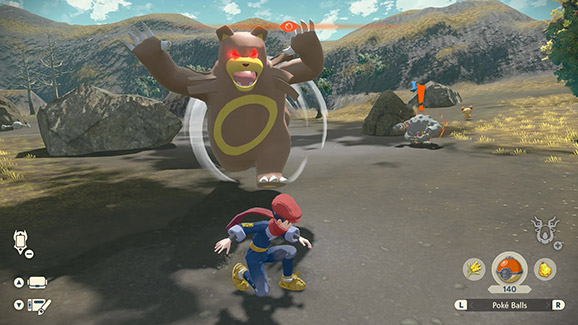
As you settle into
the community in Jubilife, though, you’ll begin to see people warm up to
Pokémon. Some will want you to catch and show them Pokémon to sate their
curiosity while others will ask you to help them find Pokémon partners of their
own. Humans and Pokémon even begin working side by side in the Jubilife Village
fields. It’s actually quite heartening to see the cooperation between people
and Pokémon begin to take hold.
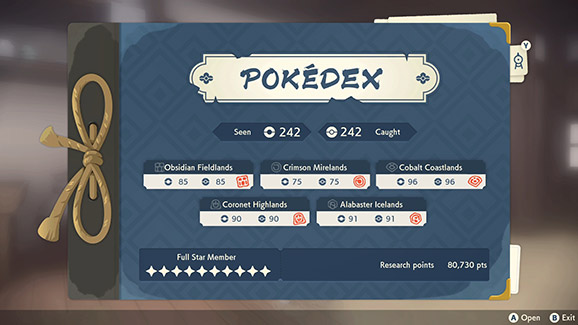
When conducting
research on Pokémon, there are few tools more valuable than a Pokédex. These high-tech
devices record all sorts of useful information about the Pokémon you encounter along
your journey. Of course, in Pokémon
Legends: Arceus, the Pokédex takes
on a wholly different form. At the start of your adventure in Hisui, you meet
Professor Laventon, who is putting together the “first complete record of its
Pokémon.” And as mentioned above, you’re uniquely qualified to help the
professor accomplish his noble goal.
Far from the
pocket-sized computer with which you might be familiar, this Pokédex—Hisui’s first Pokédex—is a humble notebook bound with string. Loose papers sticking
out the sides of the book suggests the professor frequently jots down his
observations on whatever scraps he can find before tucking them into the
Pokédex to be properly recorded later.
Since this is
Hisui’s first Pokédex, it requires a bit more work to complete each Pokémon’s
entry. You’ll have to complete multiple research tasks—like catching multiple
of the same species or observing them using a specific move a set number of
times—to bring each Pokémon’s Research Level up to 10. When you do, you’ll end
up with completed Pokédex entries that are clearly written to be personal
observations from Professor Laventon.
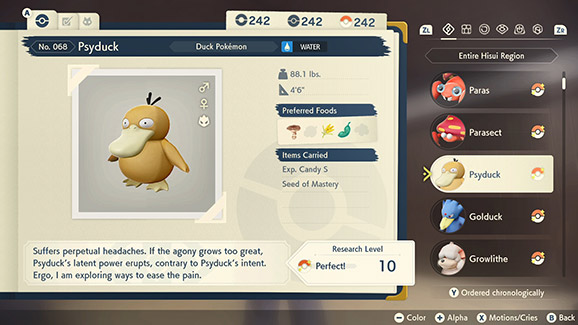
The professor occasionally
interjects with his own thoughts on the Pokémon’s behavior or with advice on
interacting with them. These expanded research tasks and intimate details
really make it feel like you’re a pioneer in the field of Pokémon research.

Poké Balls are a Pokémon
Trainer’s most invaluable tool. After all, it would be very difficult to catch
Pokémon without a bag full of these handy tools. They were created to take
advantage of Pokémon’s innate ability to shrink themselves down to a small
size, allowing them to fit comfortably inside the contoured sphere. In modern
times, Poké Balls are manufactured in factories like the one found outside of
Laverre City in the Kalos region. But in the time of the Hisui region, Poké
Balls have only just recently been invented.
Without countless
Poké Balls rolling off a production line, you’ll often have to make your own in
order to continue your research. Luckily, Poké Balls can be crafted by hand out
of an Apricorn and a Tumblestone, both of which can be readily found throughout
the Hisui region. You’ll also learn to use other materials—like Iron Chunks and
different kinds of Tumblestones—to fashion new varieties of Poké Balls.
Eventually, merchants will begin selling Poké Balls, saving you the effort of
having to handcraft your own. But it’s always good to keep a stash of crafting
materials at the ready in case you happen along a Pokémon out in the field and
your Poké Ball supply is low!
And remember,
because Poké Balls are a relatively new creation, many people have yet to
master their use. Your skills at throwing these curious creations will serve
Professor Laventon and the Galaxy Team well.
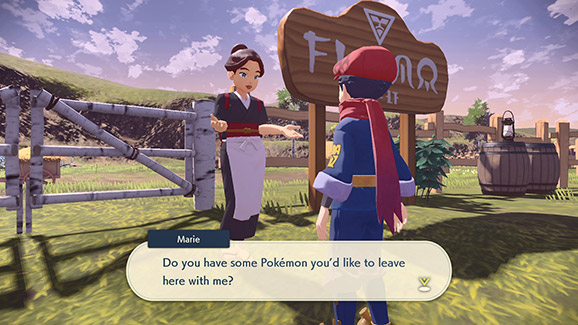
Have you caught too
many Pokémon to carry? Don’t worry, you can always pop into a Pokémon Center
and store them away in one of their handy PCs— Oh, right. Here in the Hisui
region, they haven’t even invented Pokémon Centers yet…let alone PCs!
So, what’s a
Trainer supposed to do with all the Pokémon that they can’t carry with them,
but don’t want to release? Luckily, Jubilife Village offers the perfect “storage”
solution in the form of expansive pastures. These grassy meadows operate much
like the boxes in the modern-day PCs, except instead of being stored inside a
computer, your Pokémon will freely roam these fenced-in areas when they’re not
accompanying you on your travels.
You can access your
pastures by chatting with Marie, the villager who watches over them in Jubilife
Village, or by talking to the Galaxy Member stationed at any of the base camps.
You’ll have access to only a few pastures at first, but as you collect more
Pokémon and store them, you’ll gain more pastures in which your Pokémon
partners can hang out.
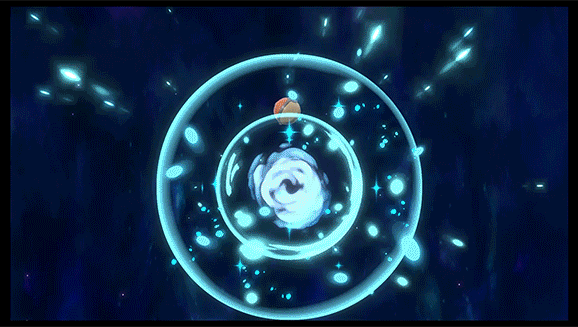
Much like storing
Pokémon, trading Pokémon in modern times is a high-tech affair. When you and
another Trainer agree to trade Pokémon, the process typically involves a lot of
flashy light displays or Poké Balls travelling though a network of tubes to
arrive at their new destination. Trading methods may not be as advanced in the
Hisui region, but they’re no less impressive.
Early Poké Balls
are equipped with a small flare that ignites when a Pokémon has been caught
within it. When you initiate a trade with one of these Poké Balls, that small
flare increases in strength, turning it into a powerful rocket that launches
the Poké Ball into the sky. The two Poké Balls pass each other en route to
their destination before arriving in their new partner’s game.
Fortunately, the
rocket’s flame causes the Poké Ball to slowly descend to the ground before it
fizzles out, allowing the Poké Ball to land with a gentle flop. You’ve got to
admire the engineering that goes into these early Poké Balls!
Life in the Hisui region may seem a bit more
primitive than what we’re used to in the world of Pokémon, but there’s no
denying the charm of seeing how people interacted with Pokémon in the past.
There’s a certain thrill in forging those first steps towards truly
understanding Pokémon and helping form the bonds that made humans and Pokémon
become such close friends.
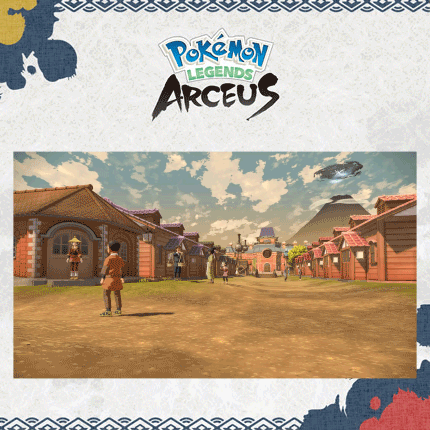
Source: Pokemon

